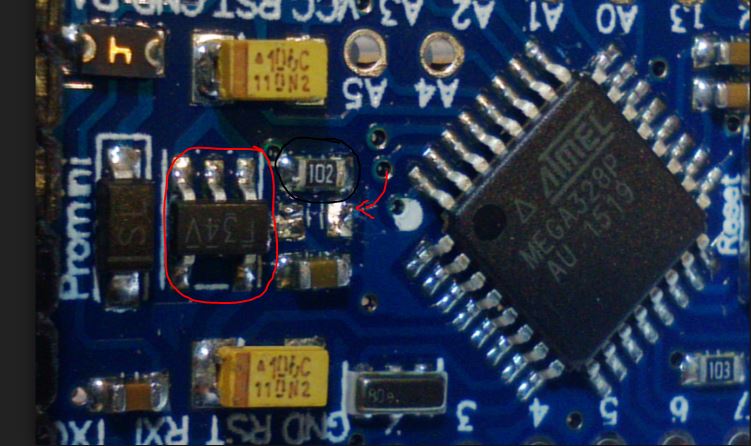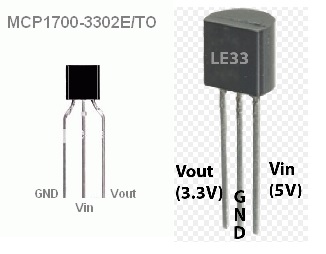💬 Easy/Newbie PCB for MySensors
-
Hmmm... Ok...
I had only read that the boosters helpt to drain the battery completely, had missed that they "messed" with the radio.
It will be really interesting to see what kind of battery life I can get out of 2 or 4 AA batteries on different types of nodes.
When I look at the Specs for the Pro Mini board the supply voltage is 3.35 - 12v.
I guess that means that without a Booster 2 AA batteries wont be able to run the Pro mini for a long time at all.@popunonkok - you are correct, they are good for they "suck all the juice" out of the batteries. Without modifications the Pro Mini 3.3v have a lowerst voltage of 2.8V (called Brown out detection) Because of that when you use 2xAA you need the booster to keep a stable 3.3v and most of the booster can convert everyhing down to 0.9v back to 3.3v. The radio can handle down to 1.9v and that will be your lowerst point.
I have nodes reading temp and humidity with a dht22 every 15min, running this setup and they last around 1 year each.
You need to search the forum and https://www.mysensors.org/build/battery for power saving with battery. The most common first step is to remove the voltage regulator and the led. Then you sleep the node when it isnt active.On this image you see the led removed (red arrow). I think its easier to remove the resistor (black circle, marked 102) but its the same result. Voltage regulater (red circle) is removed as well. Note that many sites say cut the trace but its much easier to desolder them.

Using the internal voltage regulator (3.35 - 12v) will kill the node in weeks/days if you run them on 2-4xAA because of the high current drain. My aim building a newbie/easy PCB is a sleepcurrent of 0,1mA or 100uA.
-
hi there,
Thanks for the easypcb! I'm trying to build a small solar powered weather station (like these: https://forum.mysensors.org/topic/841/solar-powered-mini-weather-station), but just found that the battery that came with the solar panel only provides 1.2v. The booster works ok and I can power the arduino, but it's no enough for the radio :-(. Since powering the radio from the booster is not a option, I'm at a dead end. Or there's a way to still using this battery/solar panel?
-
hi there,
Thanks for the easypcb! I'm trying to build a small solar powered weather station (like these: https://forum.mysensors.org/topic/841/solar-powered-mini-weather-station), but just found that the battery that came with the solar panel only provides 1.2v. The booster works ok and I can power the arduino, but it's no enough for the radio :-(. Since powering the radio from the booster is not a option, I'm at a dead end. Or there's a way to still using this battery/solar panel?
@chrlyra - you need 1.9V minimum for the radio. There are more advanced boosters you could try which probably is better and less noice... but this PCB was not designed for that purpose so sorry, I cant help you.
-
hi there,
Thanks for the easypcb! I'm trying to build a small solar powered weather station (like these: https://forum.mysensors.org/topic/841/solar-powered-mini-weather-station), but just found that the battery that came with the solar panel only provides 1.2v. The booster works ok and I can power the arduino, but it's no enough for the radio :-(. Since powering the radio from the booster is not a option, I'm at a dead end. Or there's a way to still using this battery/solar panel?
-
So a question I have always wondered about the voltage regulator is do you really need to desolder it if you connect your incoming power to the 3.3v pin and not the RAW pin? I would have thought the regulator would only drain power if it was converting the RAW power down to 3.3v.
-
So a question I have always wondered about the voltage regulator is do you really need to desolder it if you connect your incoming power to the 3.3v pin and not the RAW pin? I would have thought the regulator would only drain power if it was converting the RAW power down to 3.3v.
@dbemowsk - your logic sounds right, but i think it will draw power anyway... only way to figure out is to measure or google :)
-
I managed to change my PCB order, I saw that one of the updates to rev9 was the ability to use Pin 2 as GPIO instead of going to the Radio where it is unused. So now I have a order for Rev9 instead.
I will try to desolder the led or resistor and the voltageregulator.
Thanks for sharing your design.
-
I managed to change my PCB order, I saw that one of the updates to rev9 was the ability to use Pin 2 as GPIO instead of going to the Radio where it is unused. So now I have a order for Rev9 instead.
I will try to desolder the led or resistor and the voltageregulator.
Thanks for sharing your design.
@popunonkok Good luck - let me know if there is any other questions.
-
So a question I have always wondered about the voltage regulator is do you really need to desolder it if you connect your incoming power to the 3.3v pin and not the RAW pin? I would have thought the regulator would only drain power if it was converting the RAW power down to 3.3v.
@dbemowsk in fact current is leaking through the regulator when its input is floating, you can check the "reverse leakage current" value on the data sheet of the linear regulator used on your promini boards then decide if you can accept it or not, depending on your circuit.
-
Hi -
I wanted to know if this config is OK:
Attach a LIPO battery to PWR and GND.
Cut off the right side of the board.
Use a 3.3V pro mini.
Add a regulator (like a MCP1700) and necessary caps. (Spec says 1uF).The idea is that the board and sensors get 3.2V - 4.1 V (which should be OK).
The radio gets 3.3V.Thanks!
-
Hi -
I wanted to know if this config is OK:
Attach a LIPO battery to PWR and GND.
Cut off the right side of the board.
Use a 3.3V pro mini.
Add a regulator (like a MCP1700) and necessary caps. (Spec says 1uF).The idea is that the board and sensors get 3.2V - 4.1 V (which should be OK).
The radio gets 3.3V.Thanks!
@ileneken3 - sounds right, you should short the jumper REG which will feed everything the LIPO voltage. If this is higher than 3.3v I dont know what will happen but adding the voltage regulator for the radio will make sure that one is ok. I dont know about the pro mini, it it can handle up to 4.1v but I guess you will find out.
-
No problem with the promini. Limit is from atmega and it's 5.5V I think (at least 5V anyway :) )
You will just have HIGH level voltage at battery voltage at the outputs instead of 3.3V -
So technically you can power a 3.3V pro mini with a LiPo battery, you only need a regulator for radio, correct? Can you still make reliable battery voltage measurement? I Have a NRF24 adapter with a AMS1117 onboard, will that still work or does it need 5v?
-
So technically you can power a 3.3V pro mini with a LiPo battery, you only need a regulator for radio, correct? Can you still make reliable battery voltage measurement? I Have a NRF24 adapter with a AMS1117 onboard, will that still work or does it need 5v?
@gohan said in 💬 Easy/Newbie PCB for MySensors:
So technically you can power a 3.3V pro mini with a LiPo battery, you only need a regulator for radio, correct?
Correct.
Can you still make reliable battery voltage measurement?
I Have a NRF24 adapter with a AMS1117 onboard, will that still work or does it need 5v?
From the datasheet typical dropout voltage is 1.1V and it can be up to 1.3V.
So to get 3.3V at the output you need at least 3.3 + 1.1 = 4.4V. It won't work with your battery, you need to use another voltage regulator with a much lower dropout voltage. -
@gohan said in 💬 Easy/Newbie PCB for MySensors:
So technically you can power a 3.3V pro mini with a LiPo battery, you only need a regulator for radio, correct?
Correct.
Can you still make reliable battery voltage measurement?
I Have a NRF24 adapter with a AMS1117 onboard, will that still work or does it need 5v?
From the datasheet typical dropout voltage is 1.1V and it can be up to 1.3V.
So to get 3.3V at the output you need at least 3.3 + 1.1 = 4.4V. It won't work with your battery, you need to use another voltage regulator with a much lower dropout voltage. -
I have seen these boost/buck converters https://www.aliexpress.com/store/product/5pcs-mini-1-8V-3V-3-7V-5V-to-3-3V-Boost-Buck-Low-Noise-Regulated/1525466_32365767349.html
Would they make any sense to use with LiPo batteries or other solar power source to power a node? Or would they waste too much energy?
-
At least according to the specs, mcp1700 will do the trick (both in terms of drop out voltage and low power consumption for battery usage). I will try it.
Regarding the MCP1700 as a regulator (I ordered these: https://www.aliexpress.com/item/5-pcs-MCP1700-3302E-TO-MCP1700-Fixed-LDO-Voltage-Regulator/32781100568.html)
first connected the LIPO->TP4056->MCP1700 to the GND and PWR of the board. (I made a homemade little regulator board). From all appearances, it works great, and I end up with a nice compact sensor/battery. But I want to make use of the Easy/Newbie board. I tried hooking it up to the 3 pins marked regulator, but it didn't seem to do anything. Am I missing something? The orientation can be confusing, but I think I got it right. I measured 4.1 volts to the radio, which will fry it.
Thanks!
-
Regarding the MCP1700 as a regulator (I ordered these: https://www.aliexpress.com/item/5-pcs-MCP1700-3302E-TO-MCP1700-Fixed-LDO-Voltage-Regulator/32781100568.html)
first connected the LIPO->TP4056->MCP1700 to the GND and PWR of the board. (I made a homemade little regulator board). From all appearances, it works great, and I end up with a nice compact sensor/battery. But I want to make use of the Easy/Newbie board. I tried hooking it up to the 3 pins marked regulator, but it didn't seem to do anything. Am I missing something? The orientation can be confusing, but I think I got it right. I measured 4.1 volts to the radio, which will fry it.
Thanks!
@ileneken3 - the board is created for Le33a voltage regulator which has a different pinout than yours.
You have to adjust to that and not just put it in according to the pcb.
-
@ileneken3 - the board is created for Le33a voltage regulator which has a different pinout than yours.
You have to adjust to that and not just put it in according to the pcb.
@sundberg84
I did adjust to the different pinout. I checked it multiple times, checked soldering - it always seems like the regulator is not regulating anything - the radio always gets 4.1 volts from the LIPO.
From looking at the specs, the LE33 is pretty close - with the biggest difference that the MCP1700 can handle more current.
Maybe I should just get the LE33 ones.Oh well...
